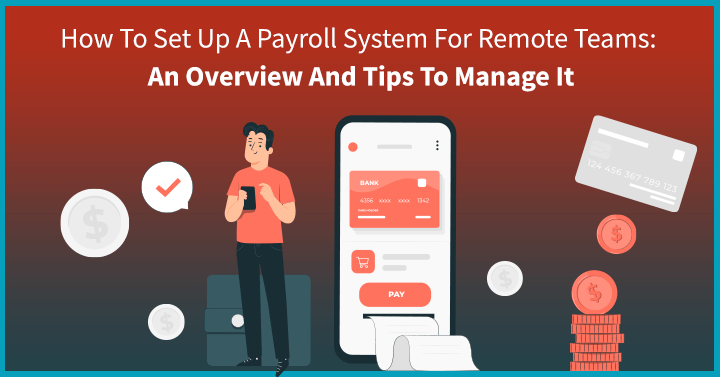As the times are changing, the remote work trend is here to stay. People are demanding flexibility in where and when they work. To attract the top talent, companies are adapting to this need. This means setting up a payroll system for remote teams is of the utmost priority to accommodate flexibility.
Companies are looking at the best practices for smooth and hassle-free compliance for paying the employees wherever they are. This guide will give you an overview of how to set up a payroll system for remote teams and how to manage it!
1 How To Set Up A Payroll System For Remote Teams
1.1 List Down The Types Of Remote Workers In Your Team
The payroll and tax liabilities depend on how you have classified your remote workforce. It would determine whether your company has to withhold and/ or pay taxes, pay overtime, comply with minimum wage laws, provide benefits, provide compensation insurance, etc. This is important to avoid any tax fines or penalties and set up a good payroll system for remote teams.
1.2 Remote Employees
Remote workers are employees who work outside of your office. The company withholds payroll taxes from them, just like they do for the in-house employees. For payroll taxes for remote employees and payroll for international employees, you must comply with the tax laws and regulations in the city/ state/ country the employee lives in.
1.3 Independent Contractors
These employees are mostly freelancers who are self-employed and not employed by the company. They are responsible for handling their own taxes. The company doesn’t have to withhold any payroll taxes from their pay. You don’t have to comply with any tax laws and regulations of the employee’s place, as they take care of it themselves.
1.4 Full-time Contractors
Full-time contractors are hired for a fixed period of time as full-time resources of the company. The tax regulations governing the withholding and reporting for full-time employees apply to them as well, regardless of who pays the wages- the hiring organization or the outsourcing firm.
2. Ensure That You Know About Different Paying Options

A good way to ensure smooth payment is to use a payment method that is popularly used wherever your remote employees live. It is most likely to comply with the laws. Convert the salary into the value of the local currency where the employee stays, and transfer the amount to their bank account. This is to set up a proper payroll system for remote teams.
2.1 Paying Options For Remote Workers In the US
For US remote workers, when you consider a good payroll system for remote teams, there are payment options such as:
2.2 Paying Options For Remote Workers In Australia
For Australian remote workers, when you consider a good payroll system for remote teams, some popular payment options are:
2.3 Paying Option For International Remote Workers
This is different from paying your local employees. You must check the international bank fees and charges for the fund transfers. Another thing to keep in mind is the exchange rates for the local currency of the employee’s country. Payroll services may also include a fee to cover the cost of the transactions, exchange, etc.
3. Consider Outsourcing To A Payroll Agency
Paying remote workers who live in various cities and countries can be tedious. You have to manage through multiple time zones, currencies, regulations, and languages. Payroll should be dealt with in a proper and orderly system to ensure there are no issues with the payments.
An outsourcing partner such as a payroll agency would be helpful in making the process easier. They deal with compliance with foreign governments and provide HR and payroll support for remote employees. This is to set up a proper payroll system for remote teams.
4. Always Keep An Eye On The Tax Structure

4.1 Taxes For Remote Employees
For payroll taxes for remote employees, you adhere to the tax regulations of the state where they reside. If they are working in the same state as your company, you will withhold state income taxes and pay unemployment insurance.
If they are residing in different states, you will have to register with their tax agencies and register with their unemployment agencies. You will be required to comply with the labor laws of that state.
4.2 Taxes For Contractors
Contract employees are responsible for managing their own taxes. For US-based freelancers, the company must take the following steps:
- Have the contractor fill out a W-9 form: This is an official document for “Request for taxpayer identification number and certification”.
- Complete a 1099 form for each contractor you’ve paid more than $600 during the year: The government will know how much you’ve paid your contractors in the non-employee compensation. A copy of this will go to the IRS and one to the contractor.
4.3 Taxes For Remote Workers In Different Countries
Working with remote employees in different countries means you have to comply with their state’s laws and regulations for payroll. When considering an effective payroll system for remote teams of international employees, you have to check for the minimum pay benefits, taxes, insurance, etc. You can outsource the payments to a payroll provider who could do the job for you hassle-free.
5. Try A Payroll Service Or Application
When considering a good payroll system for remote teams, online payroll providers give companies the tools required to handle payroll and taxes for their remote teams. These are affordable and can help you organize and keep things under your control. This is to set up a proper payroll system for remote teams.
- Remote helps you hire candidates internationally and also provides you services to manage their payroll, taxes, benefits, and compliance.
- Cloud-based HR services such as Gusto and Zenefits help you with the payroll and tax laws of your remote employees’ state.
- Services like TransferWise and TransferMate assist you in lowering the cost while sending international transactions as they allow you to send money at the exchange rate for a lower commission.
6. Which Currency Should You Use To Pay Remote Employees?
While paying remote employees abroad, you are required to pay them in their local currency at the prevailing exchange rate according to most jurisdictions. If in some countries the regulations are less stringent, the payment is done according to the agreed policies in the employment contract. In this situation, employers can specify a non-local currency or a fixed exchange rate for the pay.
 Interested in Virtual Team Building Events?
Interested in Virtual Team Building Events?





















